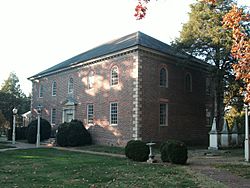Truro Parish, Virginia facts for kids
Truro Parish was like a special church district in colonial Virginia. It was part of the Anglican Church, which was the main church back then. This parish first covered all of Fairfax County. Its main church was the Truro Church. The parish got its name from a place called Truro in Cornwall, England.
Truro Parish was created on November 1, 1732. It was formed from another parish called Hamilton Parish. Over time, Truro Parish was split into smaller parts twice. In 1748, Cameron Parish was created. Then, in 1764, Fairfax Parish was formed. After 1765, Truro Parish only covered the southern part of Fairfax County. The parish system ended by 1786 when the Anglican Church was no longer the official church.
Contents
Understanding Colonial Parishes
The Anglican Church was the official church in the Colony of Virginia from 1619 to 1776. Each church district, or parish, had one minister. It was managed by a group called a vestry. This group usually had 12 wealthy local men. New parishes were created by laws passed by the House of Burgesses. This was like the local government, along with the Governor's Council.
How Truro Parish Was Formed
Truro Parish was created on November 1, 1732. The Virginia General Assembly made this decision. They divided Hamilton Parish along the Occoquan River and Bull Run. At first, Truro Parish included a very large area. This area is now Arlington, Fairfax, and Loudoun counties. It also included the cities of Alexandria, Fairfax, and Falls Church. The parish was named after Truro in Cornwall, England.
Truro Parish covered all the land north of the Occoquan River and Bull Run. It stretched up to the Potomac and west to the Blue Ridge Mountains. When it was first formed, the parish had three churches. These were Occoquan (the main church), William Gunnell's, and a chapel "above Goose Creek". The exact spots of the last two churches are not known today. But the Occoquan church is now known as Pohick Church, which you can still see.
In 1733, work began on a new church. This church was "near Michael Reagan's." It is now the site of the present-day Falls Church. In 1742, Fairfax County was created. The borders of Truro Parish were then changed to match the new county lines.
Splitting the Parish
On June 11, 1749, Truro Parish was split into two parts. The new part was called Cameron Parish. It covered the area north and west of Difficult Run and Popes Head Run. That same year, George Mason was chosen to join the vestry. He later wrote important ideas that helped create the Bill of Rights.
In 1753, the first church service was held in the new town of Alexandria. George Washington became a member of the Truro Parish vestry on October 25, 1762. His father, Augustine Washington, had also served on the vestry starting in 1735.
Truro Parish was split again on February 1, 1765. The new border was just south of George Washington's home. The northern part became Fairfax Parish, with The Falls Church as its main church. However, people in Truro Parish felt this split was unfair. They managed to get a new border drawn. This new border went through Washington's estate. This meant Washington was considered part of Truro Parish, and he was elected to its vestry again.
Today, if you look at modern maps, the final area of Truro Parish would cover the southern and southwestern parts of Fairfax County.
Places to Worship
When Truro Parish was first formed, it had three churches. These were Occoquan (now called Pohick Church), William Gunnells, and a chapel "above Goose Creek." The Goose Creek chapel later became part of Cameron Parish.
In 1766, a new church was built. It was located "on the middle ridge near Ox Road." This is now the site of Jerusalem Baptist Church, off Virginia State Route 123. The Truro Parish vestry hired Edward Payne to build this new church. It became known as "Payne's Church."
Other church buildings were also constructed. This included new buildings for The Falls Church (started in 1763, when it was still part of Truro Parish) and the current Pohick Church in 1767.


